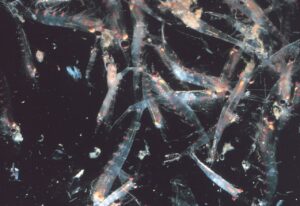Despite its small size, the Antarctic krill plays a fundamental role in the marine ecosystem. Now, scientists have developed an innovative method to count these tiny creatures from space, using differences in sea water color detected by satellites.
These crustaceans, only a few centimeters long, are an essential food source for whales, penguins, seals, and seabirds. They are also part of a natural cycle that contributes to carbon regulation on the planet. However, intensive fishing and climate change threaten their population, prompting the search for new monitoring methods.
Researchers from the University of Strathclyde, the British Antarctic Survey (BAS), and the WWF organization have developed a system that analyzes how krill density in the water modifies the amount of light absorbed by the ocean.
Dr. Cait McCarry, who recently returned from an expedition to Antarctica, explained the process: “We started with seawater and measured its light absorption. Then we added a krill, took a new measurement, and repeated the process with more specimens.” This data will allow satellites to capture changes in ocean color and, therefore, estimate the amount of krill present in Antarctic waters.

Protecting a Key Species
Krill not only sustains the lives of numerous marine animals but also influences global climate regulation. By feeding on phytoplankton that absorbs carbon and being part of the food chain for large marine mammals, their conservation is crucial.
Rod Downie, Polar Advisor at WWF-UK, warns of the urgent need to better manage krill fishing and establish marine protected areas. “This project provides us with a new tool to monitor and safeguard this vital species,” he concludes.
Thanks to the combination of satellite technology and marine science, this innovative approach could significantly improve krill conservation and, thus, the stability of the oceanic ecosystem.
What are the characteristics of krill?
Krill is a pelagic crustacean that has characteristics such as bioluminescence, being a gregarious animal, and a vital link in the food chain, with the following features:
- Biological characteristics: It is an herbivorous crustacean similar to a shrimp, with large black eyes and the ability to generate light through bioluminescence. Additionally, this animal lives in swarms.
- Dietary characteristics: It is a rich source of high-quality proteins, omega-3 fatty acids, and low in fat. In fact, it stands out for having higher antioxidant levels than fish.
- Behavioral characteristics: It migrates vertically to feed, spends the day at greater depths, and rises to the surface at night. Additionally, grouping is a defense mechanism that helps confuse small predators.
- Ecological importance: It is a vital link in the global food chain, as it is the main food source for many marine animals, such as fish, birds, and baleen whales.
- Uses: It is used as a food additive in diets, mainly in the form of high-protein krill meal.
Have you checked out our YouTube channel? Subscribe now!

